CBCL FACE DATABASE #1(CBCL人脸数据库#1)_图像处理_科研数据集
- 格式:pdf
- 大小:67.68 KB
- 文档页数:4
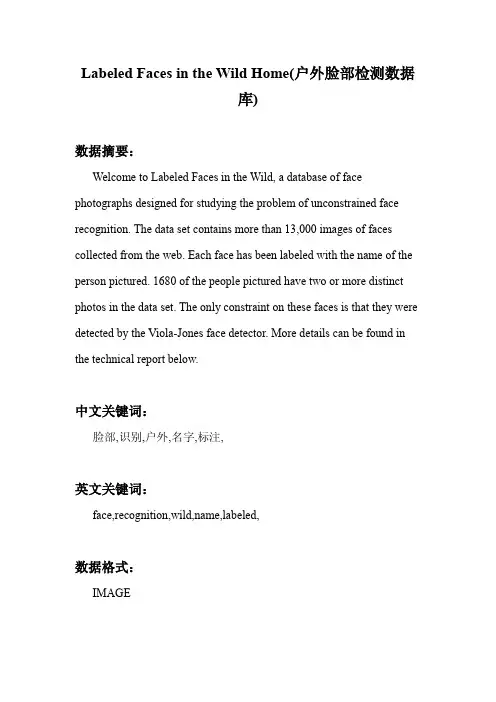
Labeled Faces in the Wild Home(户外脸部检测数据库)数据摘要:Welcome to Labeled Faces in the Wild, a database of face photographs designed for studying the problem of unconstrained face recognition. The data set contains more than 13,000 images of faces collected from the web. Each face has been labeled with the name of the person pictured. 1680 of the people pictured have two or more distinct photos in the data set. The only constraint on these faces is that they were detected by the Viola-Jones face detector. More details can be found in the technical report below.中文关键词:脸部,识别,户外,名字,标注,英文关键词:face,recognition,wild,name,labeled,数据格式:IMAGE数据用途:studying the problem of unconstrained face recognition数据详细介绍:Labeled Faces in the Wild HomeWelcome to Labeled Faces in the Wild, a database of face photographs designed for studying the problem of unconstrained face recognition. The data set contains more than 13,000 images of faces collected from the web. Each face has been labeled with the name of the person pictured. 1680 of the people pictured have two or more distinct photos in the data set. The only constraint on these faces is that they were detected by the Viola-Jones face detector. More details can be found in the technical report below.Mailing list:If you wish to receive announcements regarding any changes made to the LFW database, please send email to majordomo@ with the message body: "subscribe lfw" on a single line.Explore the database:Alphabetically by first name:[A)[Alf)[Ang)[B)[Bin)[C)[Che)[Col)[D)[Daw)[Don)[E)[Eri)[F)[G)[Goe)[H)[I)[J)[Jav)[Jes)[Joh)[Jos)[K)[Kim)[L)[Lil)[M)[Mark)[Mel)[Mik)[N)[O)[P)[Per)[Q)[R)[Ric)[Rog)[S)[Sha)[Ste)[T)[Tim)[U)[V)[W)[X)[Y)[Z)Alphabetically by first name, only people with more than one image:[A][B][C][D][E][F][G][H][I][J][K][L][M][N][O][P][Q][R][S][T][U][V][W][X][Y][Z] Alphabetically by last name:[A][B][C][D][E][F][G][H][I][J][K][L][M][N][O][P][Q][R][S][T][U][V][W][X][Y][Z]By number of images per person:[1 A-E][1 F-J][1 K-O][1 P-T][1 U-Z][2][3][4][5][6-10][11+]Single page of all names (no thumbnails)Download the database:∙All images as gzipped tar file (173MB, md5sumac79dc88658530a91423ebbba2b07bf3)∙All images aligned with funneling (233MB, md5sum1b42dfed7d15c9b2dd63d5e5840c86ad)∙All images aligned with commercial face alignment software (LFW-a - Taigman, Wolf, Hassner)∙Subset of images - people with name starting with A (14MB) as zip file∙Subset of images - George_W_Bush (individual person with most images) (6.9MB)as zip file∙All names (with number of images for given name) as text file∙README - information on file formats and directory structure Training, Validation, and Testing:View 1:For development purposes, we recommend using the below training/testing split, which was generated randomly and independently of the splits for 10-fold cross validation, to avoid unfairly overfitting to the sets above during development. For instance, these sets may be viewed as a model selection set and a validation set. See the tech report below for more details.Explore the sets: [training][test]Download the sets: pairsDevTrain.txt, pairsDevTest.txt, peopleDevTrain.txt, peopleDevTest.txtView 2:As a benchmark for comparison, we suggest reporting performance as 10-fold cross validation using splits we have randomly generated.For information on the file formats, please refer to the README above.For details on how the sets were created, please refer to the tech report below. Results:Accuracy and ROC curves for various methods available on results page. Information:13233 images5749 people1680 people with two or more imagesErrata:The following is a list of known errors in LFW. Due to the small number of such errors, the database will be left as is (without corrections) to avoid confusion.It is important that users of the database provide their algorithms with the database as is, i.e. without correcting the errors below, since previous results published for the database did not have the advantage of correcting for these errors.Note: unless stated otherwise below, any error in a matched pair will mean thatthe label ("matched") is wrong. Any error in a mismatched pair, even with the person having the wrong identity, will generally be correct (the label of "mismatched" will still be correct).Recep_Tayyip_Erdogan_0004 is incorrect (it is an image of Abdullah Gul). This image appears only in one matched pair in the training set of View 1. Janica_Kostelic_0001 is incorrect (it is an image of Anja Paerson).This image appears in one matched pair in the test set of View 1, and in one matched pair and one mismatched pair (with Don_Carcieri_0001) in fold 1 of View 2.Bart_Hendricks_0001 is incorrect (it is a duplicate image of Ricky_Ray_0001). This image appears in two mismatched pairs in the training set of View 1, and one mismatched pair in fold 2 of View 2. (None of the mismatched pairs are with Ricky_Ray.)Carlos_Beltran_0001 is incorrect (it is a duplicate image of Raul_Ibanez_0001). This image appears in one mismatched pair in the test set of View 1, and one mismatched pair in fold 5 of View 2. (None of the mismatched pairs are with Raul_Ibanez.)Emmy_Rossum_0001 is incorrect (it is a duplicate image of Eva_Amurri_0001). This image appears in one mismatched pair in the test set of View 1 (the mismatched pair is not with Eva_Amurri).Michael_Schumacher_0008 is incorrect (it is an image of Rubens Barrichello). This image does not appear in a matched or mismatched pair, in either view. Reference:Please cite as:Gary B. Huang, Manu Ramesh, Tamara Berg, and Erik Learned-Miller. Labeled Faces in the Wild: A Database for Studying Face Recognition in Unconstrained Environments.University of Massachusetts, Amherst, Technical Report 07-49, October, 2007. 数据预览:点此下载完整数据集。
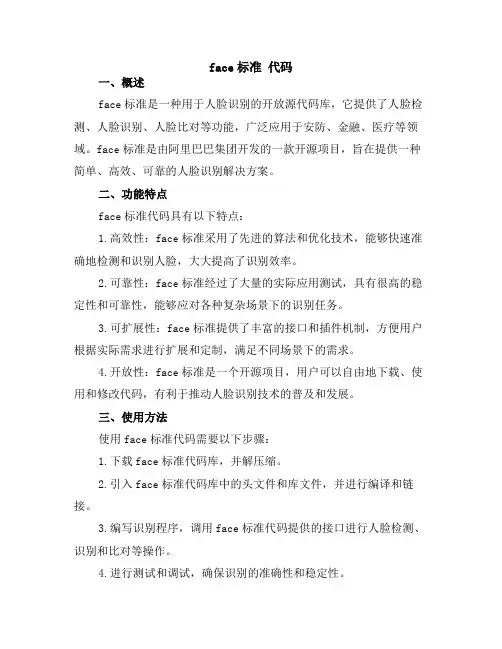
face标准代码一、概述face标准是一种用于人脸识别的开放源代码库,它提供了人脸检测、人脸识别、人脸比对等功能,广泛应用于安防、金融、医疗等领域。
face标准是由阿里巴巴集团开发的一款开源项目,旨在提供一种简单、高效、可靠的人脸识别解决方案。
二、功能特点face标准代码具有以下特点:1.高效性:face标准采用了先进的算法和优化技术,能够快速准确地检测和识别人脸,大大提高了识别效率。
2.可靠性:face标准经过了大量的实际应用测试,具有很高的稳定性和可靠性,能够应对各种复杂场景下的识别任务。
3.可扩展性:face标准提供了丰富的接口和插件机制,方便用户根据实际需求进行扩展和定制,满足不同场景下的需求。
4.开放性:face标准是一个开源项目,用户可以自由地下载、使用和修改代码,有利于推动人脸识别技术的普及和发展。
三、使用方法使用face标准代码需要以下步骤:1.下载face标准代码库,并解压缩。
2.引入face标准代码库中的头文件和库文件,并进行编译和链接。
3.编写识别程序,调用face标准代码提供的接口进行人脸检测、识别和比对等操作。
4.进行测试和调试,确保识别的准确性和稳定性。
四、示例代码以下是一个简单的示例代码,用于演示如何使用face标准代码进行人脸识别:```c++#include<iostream>#include"facerec/facerec.h"usingnamespacestd;usingnamespaceface;intmain(){//创建人脸识别器对象FaceRecPtrrec=FaceRec::create();//加载人脸图片Matimg=imread("test.jpg");//进行人脸检测和识别vector<Rect>faces=rec->detectMulti(img);vector<string>ids=rec->recognizeMulti(img,faces);//输出识别结果for(inti=0;i<faces.size();i++){cout<<"Face"<<i+1<<":"<<endl;cout<<"Id:"<<ids[i]<<endl;cout<<"Confidence:"<<rec->getConfidence(faces[i])<<endl;}return0;}```五、注意事项在使用face标准代码时,需要注意以下几点:1.确保系统环境符合要求,包括操作系统、编译器等。
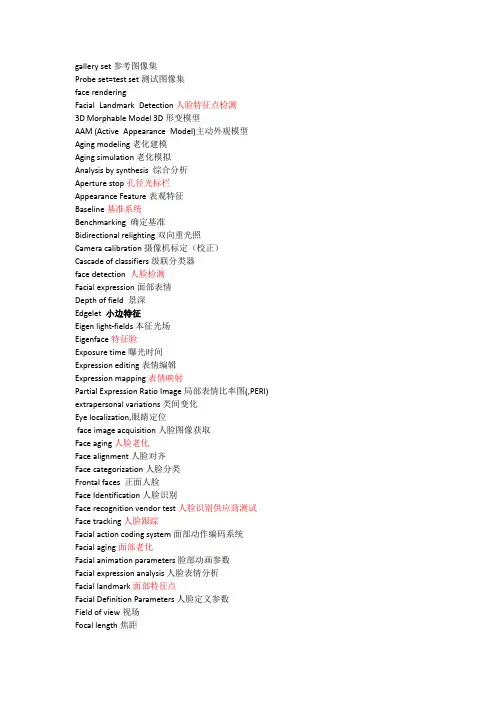
gallery set参考图像集Probe set=test set测试图像集face renderingFacial Landmark Detection人脸特征点检测3D Morphable Model 3D形变模型AAM (Active Appearance Model)主动外观模型Aging modeling老化建模Aging simulation老化模拟Analysis by synthesis 综合分析Aperture stop孔径光标栏Appearance Feature表观特征Baseline基准系统Benchmarking 确定基准Bidirectional relighting 双向重光照Camera calibration摄像机标定(校正)Cascade of classifiers 级联分类器face detection 人脸检测Facial expression面部表情Depth of field 景深Edgelet 小边特征Eigen light-fields本征光场Eigenface特征脸Exposure time曝光时间Expression editing表情编辑Expression mapping表情映射Partial Expression Ratio Image局部表情比率图(,PERI) extrapersonal variations类间变化Eye localization,眼睛定位face image acquisition 人脸图像获取Face aging人脸老化Face alignment人脸对齐Face categorization人脸分类Frontal faces 正面人脸Face Identification人脸识别Face recognition vendor test人脸识别供应商测试Face tracking人脸跟踪Facial action coding system面部动作编码系统Facial aging面部老化Facial animation parameters脸部动画参数Facial expression analysis人脸表情分析Facial landmark面部特征点Facial Definition Parameters人脸定义参数Field of view视场Focal length焦距Geometric warping几何扭曲Street view街景Head pose estimation头部姿态估计Harmonic reflectances谐波反射Horizontal scaling水平伸缩Identification rate识别率Illumination cone光照锥Inverse rendering逆向绘制技术Iterative closest point迭代最近点Lambertian model朗伯模型Light-field光场Local binary patterns局部二值模式Mechanical vibration机械振动Multi-view videos多视点视频Band selection波段选择Capture systems获取系统Frontal lighting正面光照Open-set identification开集识别Operating point操作点Person detection行人检测Person tracking行人跟踪Photometric stereo光度立体技术Pixellation像素化Pose correction姿态校正Privacy concern隐私关注Privacy policies隐私策略Profile extraction轮廓提取Rigid transformation刚体变换Sequential importance sampling序贯重要性抽样Skin reflectance model,皮肤反射模型Specular reflectance镜面反射Stereo baseline 立体基线Super-resolution超分辨率Facial side-view面部侧视图Texture mapping纹理映射Texture pattern纹理模式Rama Chellappa读博计划:1.完成先前关于指纹细节点统计建模的相关工作。
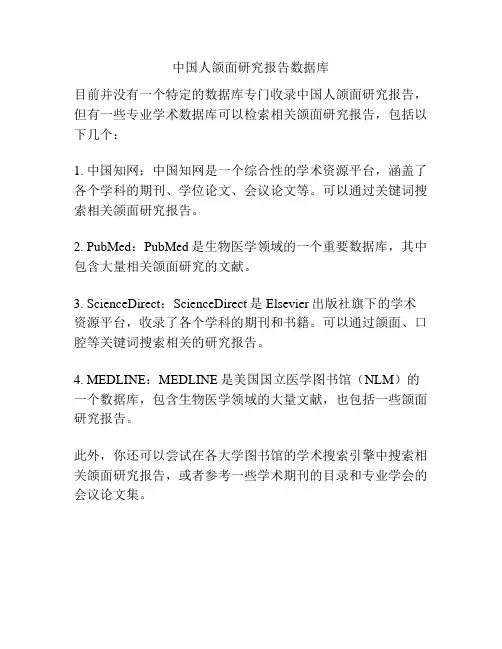
中国人颌面研究报告数据库
目前并没有一个特定的数据库专门收录中国人颌面研究报告,但有一些专业学术数据库可以检索相关颌面研究报告,包括以下几个:
1. 中国知网:中国知网是一个综合性的学术资源平台,涵盖了各个学科的期刊、学位论文、会议论文等。
可以通过关键词搜索相关颌面研究报告。
2. PubMed:PubMed是生物医学领域的一个重要数据库,其中包含大量相关颌面研究的文献。
3. ScienceDirect:ScienceDirect是Elsevier出版社旗下的学术资源平台,收录了各个学科的期刊和书籍。
可以通过颌面、口腔等关键词搜索相关的研究报告。
4. MEDLINE:MEDLINE是美国国立医学图书馆(NLM)的一个数据库,包含生物医学领域的大量文献,也包括一些颌面研究报告。
此外,你还可以尝试在各大学图书馆的学术搜索引擎中搜索相关颌面研究报告,或者参考一些学术期刊的目录和专业学会的会议论文集。
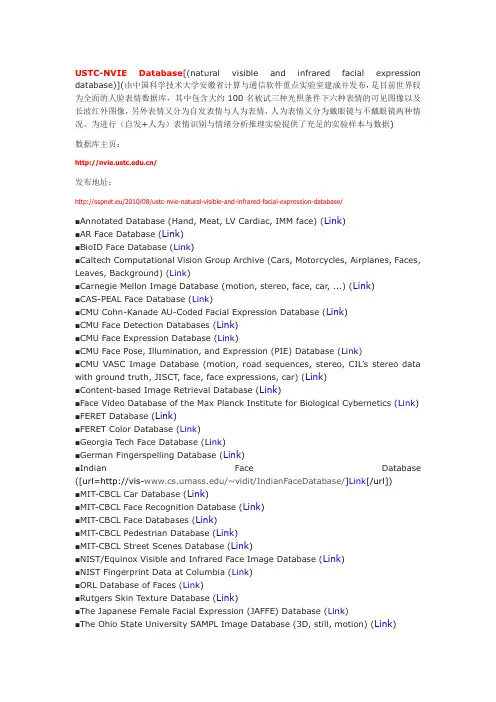
USTC-NVIE Database[(natural visible and infrared facial expression database)](由中国科学技术大学安徽省计算与通信软件重点实验室建成并发布,是目前世界较为全面的人脸表情数据库,其中包含大约100名被试三种光照条件下六种表情的可见图像以及长波红外图像,另外表情又分为自发表情与人为表情,人为表情又分为戴眼镜与不戴眼镜两种情况。
为进行(自发+人为)表情识别与情绪分析推理实验提供了充足的实验样本与数据)数据库主页:/发布地址:http://sspnet.eu/2010/08/ustc-nvie-natural-visible-and-infrared-facial-expression-database/■Annotated Database (Hand, Meat, LV Cardiac, IMM face) (Link)■AR Face Database (Link)■BioID Face Database (Link)■Caltech Computational Vision Group Archive (Cars, Motorcycles, Airplanes, Faces, Leaves, Background) (Link)■Carnegie Mellon Image Database (motion, stereo, face, car, ...) (Link)■CAS-PEAL Face Database (Link)■CMU Cohn-Kanade AU-Coded Facial Expression Database (Link)■CMU Face Detection Databases (Link)■CMU Face Expression Database (Link)■CMU Face Pose, Illumination, and Expression (PIE) Database (Link)■CMU VAS C Image Database (motion, road sequences, stereo, CIL’s stereo data with ground truth, JISCT, face, face expressions, car) (Link)■Content-based Image Retrieval Database (Link)■Face Video Database of the Max Planck Institute for Biological Cybernetics (Link)■FERET Database (Link)■FERET Color Database (Link)■Georgia Tech Face Database (Link)■German Fingerspelling Database (Link)■Indian Face Database ([url=/~vidit/IndianFaceDatabase/]Link[/url])■MIT-CBCL Car Database (Link)■MIT-CBCL Face Recognition Database (Link)■MIT-CBCL Face Databases (Link)■MIT-CBCL Pedestrian Database (Link)■MIT-CBCL Street Scenes Database (Link)■NIST/Equinox Visible and Infrared Face Image Database (Link)■NIST Fingerprint Data at Columbia (Link)■ORL Database of Faces (Link)■Rutgers Skin Texture Database (Link)■The Japanese Female Facial Expression (JAFFE) Database (Link)■The Ohio State University SAMPL Image Database (3D, still, motion) (Link)■The University of Oulu Physics-Based Face Database (Link)■UMIST Face Database (Link)■USF Range Image Data (with ground truth) (Link)■Usenix Face Database (hundreds of images, several formats) (Link)■UCI Machine Learning Repository (Link)■USC-SIPI Image Database (collection of digitized images) (Link)■UCD VALID Database (multimodal for still face, audio, and video) (Link)■UCD Color Face Image (UCFI) Database for Face Detection (Link)■UCL M2VTS Multimodal Face Database (Link)■Vision Image Archive at UMass (sequences, stereo, medical, indoor, outlook, road, underwater, aerial, satellite, space and more) (Link)■Where can I find Lenna and other images? (Link)■Yale Face Database (Link)■Yale Face Database B (Link)。
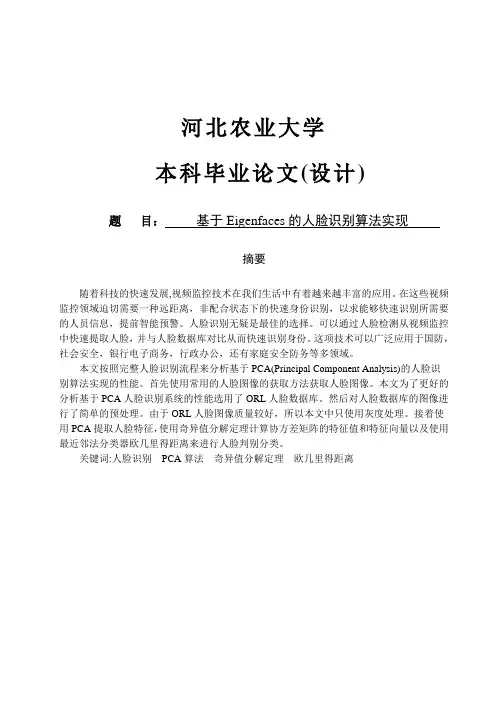
河北农业大学本科毕业论文(设计)题目:基于Eigenfaces的人脸识别算法实现摘要随着科技的快速发展,视频监控技术在我们生活中有着越来越丰富的应用。
在这些视频监控领域迫切需要一种远距离,非配合状态下的快速身份识别,以求能够快速识别所需要的人员信息,提前智能预警。
人脸识别无疑是最佳的选择。
可以通过人脸检测从视频监控中快速提取人脸,并与人脸数据库对比从而快速识别身份。
这项技术可以广泛应用于国防,社会安全,银行电子商务,行政办公,还有家庭安全防务等多领域。
本文按照完整人脸识别流程来分析基于PCA(Principal Component Analysis)的人脸识别算法实现的性能。
首先使用常用的人脸图像的获取方法获取人脸图像。
本文为了更好的分析基于PCA人脸识别系统的性能选用了ORL人脸数据库。
然后对人脸数据库的图像进行了简单的预处理。
由于ORL人脸图像质量较好,所以本文中只使用灰度处理。
接着使用PCA提取人脸特征,使用奇异值分解定理计算协方差矩阵的特征值和特征向量以及使用最近邻法分类器欧几里得距离来进行人脸判别分类。
关键词:人脸识别PCA算法奇异值分解定理欧几里得距离ABSTRACTWith the rapid development of technology, video surveillance technology has become increasingly diverse applications in our lives. In these video surveillance urgent need for a long-range, with rapid identification of non-state, in order to be able to quickly identify people the information they need, advance intelligence warning. Face recognition is undoubtedly the best choice. Face detection can quickly extract human faces from video surveillance, and contrast with the face database to quickly identify identity. This technology can be widely used in national defense, social security, bank e-commerce, administrative offices, as well as home security and defense and other areas.In accordance with the full recognition process to analyze the performance of PCA-based face recognition algorithm. The first to use the method of access to commonly used face images for face images. In order to better analysis is based on the performance of the PCA face recognition system selected ORL face database. Then the image face database for a simple pretreatment. Because ORL face image quality is better, so this article uses only gray scale processing. Then use the PCA for face feature extraction using singular value decomposition theorem to calculate the covariance matrix of the eigenvalues and eigenvectors, and use the Euclidean distance of the nearest neighbor classifier to the classification of human face discrimination.KEYWORDS: face recognition PCA algorithm SVD Euclidean distance目录摘要 (1)ABSTRACT (2)1 人脸识别概述 (4)1.1 人脸识别的研究概况和发展趋势 (4)1.1.1 人脸识别的研究概况 (4)1.1.2 人脸识别的发展趋势 (5)1.2 人脸识别的主要难点 (6)1.3 人脸识别的流程 (6)1.3.1 人脸图像采集 (7)1.3.2 预处理 (7)1.3.3 特征提取 (7)1.4 本章小结 (8)2 人脸图像 (9)2.1 人脸图像获取 (9)2.2 人脸图像数据库 (9)2.3 人脸图像预处理 (10)2.3.1 灰度变化 (10)2.3.2 二值化 (11)2.3.3 图像锐化 (11)2.4 本章小结 (12)3 人脸识别 (13)3.1 PCA算法理论 (13)3.2 PCA人脸识别算法的实现 (14)3.2.1 K-L变换 (14)3.2.2 SVD 定理 (14)3.2.3 PCA算法 (15)3.2.4 人脸识别过程 (16)3.3 程序运行效果 (16)3.4 程序代码 (17)3.4.1 代码类关系 (17)3.4.2 代码的OpenCV相关 (18)3.4.3 关键函数代码 (18)3.5 本章小结 (22)结论 (23)致谢 (24)参考文献 (25)1人脸识别概述1.1 人脸识别的研究概况和发展趋势1.1.1 人脸识别的研究概况人脸识别的研究开始于上世纪七十年代,当时的研究主要是基于人脸外部轮廓的方法。
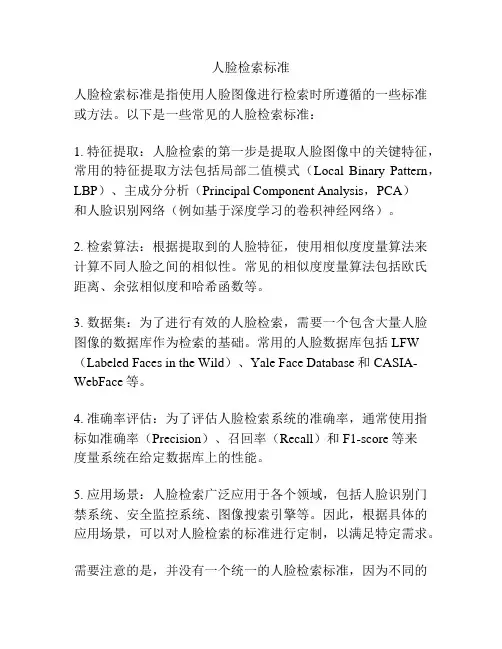
人脸检索标准
人脸检索标准是指使用人脸图像进行检索时所遵循的一些标准或方法。
以下是一些常见的人脸检索标准:
1. 特征提取:人脸检索的第一步是提取人脸图像中的关键特征,常用的特征提取方法包括局部二值模式(Local Binary Pattern,LBP)、主成分分析(Principal Component Analysis,PCA)
和人脸识别网络(例如基于深度学习的卷积神经网络)。
2. 检索算法:根据提取到的人脸特征,使用相似度度量算法来计算不同人脸之间的相似性。
常见的相似度度量算法包括欧氏距离、余弦相似度和哈希函数等。
3. 数据集:为了进行有效的人脸检索,需要一个包含大量人脸图像的数据库作为检索的基础。
常用的人脸数据库包括LFW (Labeled Faces in the Wild)、Yale Face Database和CASIA-WebFace等。
4. 准确率评估:为了评估人脸检索系统的准确率,通常使用指标如准确率(Precision)、召回率(Recall)和F1-score等来
度量系统在给定数据库上的性能。
5. 应用场景:人脸检索广泛应用于各个领域,包括人脸识别门禁系统、安全监控系统、图像搜索引擎等。
因此,根据具体的应用场景,可以对人脸检索的标准进行定制,以满足特定需求。
需要注意的是,并没有一个统一的人脸检索标准,因为不同的
应用场景和需求可能需要不同的方法和度量指标。
因此,在实际应用中,需要根据实际情况选择合适的标准和方法。
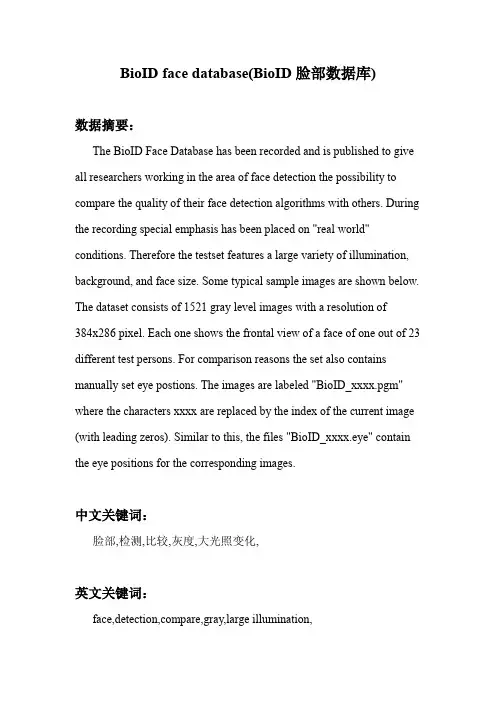
BioID face database(BioID脸部数据库)数据摘要:The BioID Face Database has been recorded and is published to give all researchers working in the area of face detection the possibility to compare the quality of their face detection algorithms with others. During the recording special emphasis has been placed on "real world" conditions. Therefore the testset features a large variety of illumination, background, and face size. Some typical sample images are shown below. The dataset consists of 1521 gray level images with a resolution of384x286 pixel. Each one shows the frontal view of a face of one out of 23 different test persons. For comparison reasons the set also contains manually set eye postions. The images are labeled "BioID_xxxx.pgm" where the characters xxxx are replaced by the index of the current image (with leading zeros). Similar to this, the files "BioID_xxxx.eye" contain the eye positions for the corresponding images.中文关键词:脸部,检测,比较,灰度,大光照变化,英文关键词:face,detection,compare,gray,large illumination,数据格式:IMAGE数据用途:to give all researchers working in the area of face detection the possibility to compare the quality of their face detection algorithms with others.数据详细介绍:BioID face databaseThe BioID Face Database has been recorded and is published to give all researchers working in the area of face detection the possibility to compare the quality of their face detection algorithms with others. During the recording special emphasis has been placed on "real world" conditions. Therefore the testset features a large variety of illumination, background, and face size. Some typical sample images are shown below.Description of the face databaseThe dataset consists of 1521 gray level images with a resolution of 384x286 pixel. Each one shows the frontal view of a face of one out of 23 different test persons. For comparison reasons the set also contains manually set eye postions. The images are labeled "BioID_xxxx.pgm" where the characters xxxx are replaced by the index of the current image (with leading zeros). Similar to this, the files "BioID_xxxx.eye" contain the eye positions for the corresponding images.Image file formatThe images are stored in single files using the portable gray map (pgm) data format. A pgm file contains a data header followed by the image data. In our case the header consists of four lines of text. In detail:the first line describes the format of the image data (ASCII/binary). In our files the text "P5" indicates that the data is written in binary formthe second line contains the image width written in text formthe third line keeps the image height also in text formthe fourth line contains the maximum allowed gray value (255 in our images) The header is followed by a data block containing the image data. The data is stored line per line from top to bottom using one byte per pixel.Eye position file formatThe eye position files are text files containing a single comment line followed by the x and the y coordinate of the left eye and the x and the y coordinate of the right eye separated by spaces. Note that we refer to the left eye as the person's left eye. Therefore, when captured by a camera, the position of the left eye is on the image's right and vice versa.Evaluation of face detection algorithmsTo make it possible to compare the quality of different face detection algorithms on the testset we propose the following distance-based quality measure:Estimate the eye positions with your algorithm and calculate the absolute pixel distance from the manually set positions so that you receive two distance values.Choose the larger value and divide by the absolute pixel distance of the two manually set eye positions so that you become independent from the face's size in the image. We call this value relative eye distance.When calculating this distance for each image you can choose the distribution function of the relative distances to compare some results with others. Alternatively we recommend to rate a face as found if the relative distance is equal to or less than 0.25, which corresponds to an accuracy of about half the width of an eye in the image. The detection rate can directly be calculated by dividing the number of correctly found faces by the total number of faces in the dataset.数据预览:点此下载完整数据集。
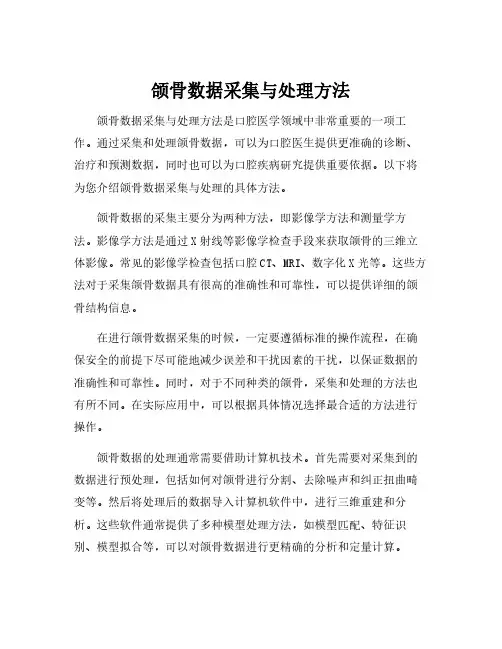
颌骨数据采集与处理方法颌骨数据采集与处理方法是口腔医学领域中非常重要的一项工作。
通过采集和处理颌骨数据,可以为口腔医生提供更准确的诊断、治疗和预测数据,同时也可以为口腔疾病研究提供重要依据。
以下将为您介绍颌骨数据采集与处理的具体方法。
颌骨数据的采集主要分为两种方法,即影像学方法和测量学方法。
影像学方法是通过X射线等影像学检查手段来获取颌骨的三维立体影像。
常见的影像学检查包括口腔CT、MRI、数字化X光等。
这些方法对于采集颌骨数据具有很高的准确性和可靠性,可以提供详细的颌骨结构信息。
在进行颌骨数据采集的时候,一定要遵循标准的操作流程,在确保安全的前提下尽可能地减少误差和干扰因素的干扰,以保证数据的准确性和可靠性。
同时,对于不同种类的颌骨,采集和处理的方法也有所不同。
在实际应用中,可以根据具体情况选择最合适的方法进行操作。
颌骨数据的处理通常需要借助计算机技术。
首先需要对采集到的数据进行预处理,包括如何对颌骨进行分割、去除噪声和纠正扭曲畸变等。
然后将处理后的数据导入计算机软件中,进行三维重建和分析。
这些软件通常提供了多种模型处理方法,如模型匹配、特征识别、模型拟合等,可以对颌骨数据进行更精确的分析和定量计算。
在处理颌骨数据的过程中,还需要注意数据的精度、可重复性和可视化效果。
这些因素将直接影响到处理结果和数据的应用价值。
因此,在进行数据处理时,一定要使用高质量的软件、硬件和算法,同时对数据的精度和可靠性进行严格的检验,以保证数据的最大化利用。
总之,颌骨数据采集与处理是口腔医学中不可缺少的一部分。
通过采集和处理颌骨数据,可以提供更准确的诊断、治疗和预测信息,为口腔医学和口腔疾病研究提供更精确的依据。
因此,我们需要选择正确的采集和处理方法,并使用高质量的技术和算法,以确保数据的准确性和可靠性,使其发挥最大的价值。
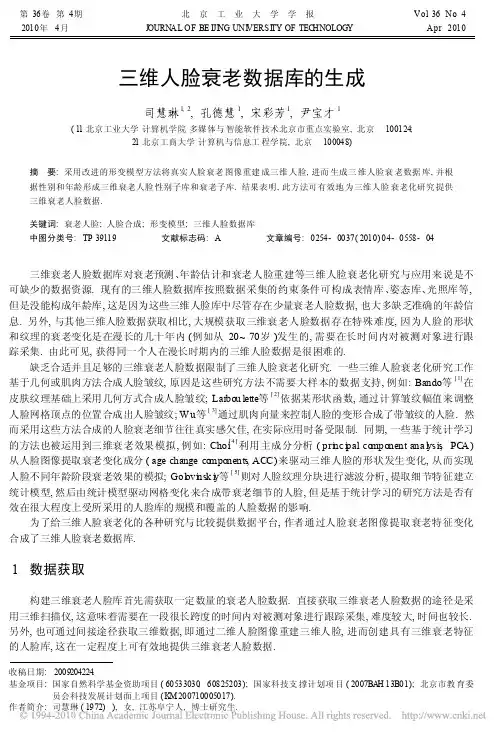
第36卷第4期2010年4月北京工业大学学报J OURN AL OF BE IJI NG UNI VERS I TY OF TEC HNOLOG YVo.l 36No .4Apr .2010三维人脸衰老数据库的生成司慧琳1,2,孔德慧1,宋彩芳1,尹宝才1(11北京工业大学计算机学院多媒体与智能软件技术北京市重点实验室,北京 100124;21北京工商大学计算机与信息工程学院,北京 100048)摘 要:采用改进的形变模型方法将真实人脸衰老图像重建成三维人脸,进而生成三维人脸衰老数据库,并根据性别和年龄形成三维衰老人脸性别子库和衰老子库.结果表明,此方法可有效地为三维人脸衰老化研究提供三维衰老人脸数据.关键词:衰老人脸;人脸合成;形变模型;三维人脸数据库中图分类号:TP 39119文献标志码:A 文章编号:0254-0037(2010)04-0558-04收稿日期:2009204224.基金项目:国家自然科学基金资助项目(60533030,60825203);国家科技支撑计划项目(2007BA H 13B01);北京市教育委员会科技发展计划面上项目(K M 200710005017).作者简介:司慧琳(1972)),女,江苏阜宁人,博士研究生.三维衰老人脸数据库对衰老预测、年龄估计和衰老人脸重建等三维人脸衰老化研究与应用来说是不可缺少的数据资源.现有的三维人脸数据库按照数据采集的约束条件可构成表情库、姿态库、光照库等,但是没能构成年龄库,这是因为这些三维人脸库中尽管存在少量衰老人脸数据,也大多缺乏准确的年龄信息.另外,与其他三维人脸数据获取相比,大规模获取三维衰老人脸数据存在特殊难度,因为人脸的形状和纹理的衰老变化是在漫长的几十年内(例如从20~70岁)发生的,需要在长时间内对被测对象进行跟踪采集.由此可见,获得同一个人在漫长时期内的三维人脸数据是很困难的.缺乏合适并且足够的三维衰老人脸数据限制了三维人脸衰老化研究.一些三维人脸衰老化研究工作基于几何或肌肉方法合成人脸皱纹,原因是这些研究方法不需要大样本的数据支持,例如:Bando 等[1]在皮肤纹理基础上采用几何方式合成人脸皱纹;Lar bou lette 等[2]依据某形状函数,通过计算皱纹幅值来调整人脸网格顶点的位置合成出人脸皱纹;Wu 等[3]通过肌肉向量来控制人脸的变形合成了带皱纹的人脸.然而采用这些方法合成的人脸衰老细节往往真实感欠佳,在实际应用时备受限制.同期,一些基于统计学习的方法也被运用到三维衰老效果模拟,例如:Choi [4]利用主成分分析(pri n c i p al co mponent ana l y sis ,PC A )从人脸图像提取衰老变化成分(age change co mponents ,ACC)来驱动三维人脸的形状发生变化,从而实现人脸不同年龄阶段衰老效果的模拟;Gol o vi n sk i y 等[5]则对人脸纹理分块进行滤波分析,提取细节特征建立统计模型,然后由统计模型驱动网格变化来合成带衰老细节的人脸,但是基于统计学习的研究方法是否有效在很大程度上受所采用的人脸库的规模和覆盖的人脸数据的影响.为了给三维人脸衰老化的各种研究与比较提供数据平台,作者通过人脸衰老图像提取衰老特征变化合成了三维人脸衰老数据库.1 数据获取构建三维衰老人脸库首先需获取一定数量的衰老人脸数据.直接获取三维衰老人脸数据的途径是采用三维扫描仪,这意味着需要在一段很长跨度的时间内对被测对象进行跟踪采集,难度较大,时间也较长.另外,也可通过间接途径获取三维数据,即通过二维人脸图像重建三维人脸,进而创建具有三维衰老特征的人脸库,这在一定程度上可有效地提供三维衰老人脸数据.第4期司慧琳,等:三维人脸衰老数据库的生成111 基于三维数据扫描仪的数据获取近年来,随着三维数字化扫描仪的应用,直接利用三维数据进行建库日趋增多.国际典型的人脸库是德国Vetter 等[6]使用形变和光流的方法建立的MPI 三维人脸数据库,大约200人规模.国内BJ UT 23D 人脸库是目前最大的中国人三维人脸数据库[7],包括1200名中国人的三维人脸数据,其中500人的数据对外公开发布(男女各250人,年龄分布在16~49岁),人脸数据均是中性表情.112 二维衰老图像的数据获取图像数据的获取比三维数据扫描简单.依据二维图像构建人脸衰老图像库目前已有报道,最为经典的是塞浦路斯大学的FG 2NET 衰老人脸图像库[8],大约有1000张左右人脸图像(主要来自旧照片的扫描)以及详细的年龄信息(年龄段为0~69岁),包括82个人,每个人大约12幅图像,部分图像还提供标定形状的关键点位置数据.FG 2NET 数据库中每个被测对象都具有不同年龄段的多幅人脸图像,有助于人脸数据的建模和仿真.2 三维人脸衰老数据库生成211 基于图像的特定三维人脸重建本文选择FG 2NET 衰老人脸图像库的人脸图像,采用W ang 等[9]提出的三维人脸主动形变模型(3D acti v e morphab le mode,l 3D 2A M M)和一种遗传算法的模型匹配方法不断调整模型参数来实现三维人脸的自动重建,间接得到了三维人脸的衰老数据.该方法与基于多视点照片的经典人脸合成方法也完全不同,它通过数据库中人脸向量的运算来产生新的人脸.该方法是一种改进的形变模型方法,在模型的匹配速度、重建精度和效率方面都得到提高.在三维主动形变模型中,原始三维人脸的形状和纹理分别表示成形状向量和纹理向量,即S i =(X i 1,Y i 1,Z i 1,X i 2,,,X in ,Y in ,Z in )T ,T i =(R i 1,G i 1,B i 1,R i 2,,,R in ,G in ,B in )T (1)其中,1[i [N,N 为三维人脸的个数;S i 为第i 个三维人脸顶点坐标组成的几何形状向量;T i 为由三维人脸顶点对应纹理值(R,G ,B)形成的纹理向量;n 为三维人脸的顶点个数.对三维人脸的形状向量和纹理向量进行线性组合即可产生新的人脸向量S new =E N i a i S i ,T n e w =E N i b i T i (2)式中a i 、b i 为原型人脸的组合系数,且E N i a i =E N ib i =1.基于三维人脸主动形变模型重建出的三维人脸结果如图1所示.图1 基于图像的三维人脸重建结果F i g .1 Or i gi na l i m ages and three 2di m ensi onal reco nstructio n resu lts图1表明,衰老人脸图像中衰老细节(如皱纹、眼袋等)在三维重建人脸中基本得到了保持.这说明由三维主动形变模型重建出三维人脸可作为一种新的真实感三维人脸合成方法来有效地保持细节.559北 京 工 业 大 学 学 报2010年图2 特征点标定F i g .2 Labeli ng of feature poi nts 需说明的是,从FG 2NET 库中选择的图像来自旧照片扫描,其人脸大小、姿态、表情、光照等相差很大,在重建三维人脸前,为了保证所提取的人脸区域基本正确,先从人脸图像中选择代表个人相貌的特征点.因为人脸主要由眼睛、鼻子、嘴巴、下巴等部件构成,这些部件的形状特征具有稳定性,能充分标示人脸区域,所以本文在人脸的上述部件上共选取了9个特征点并通过鼠标在图像上进行了手工标定,如图2所示.图中白色点是手工标定的特征点.特征点的标定使得大小不同、姿态各异的人脸图像在重建三维人脸时取得了一定的矫正,如图3所示.这是因为无论脸部图像大小和姿态差异如何,在重建三维人脸前已经依据特征点的标定做了相应的调整,并且最终生成的三维人脸都具有相同的拓扑结构,有125601个顶点,组合成249856个三角面片.图3 大小和姿态各异的三维人脸重建结果F i g .3 R esu lts of three 2d i m ensi onal face reconstructi on processing d ifferent size and pose212 三维人脸衰老数据库的生成人脸衰老变化通常在20岁之后发生,因此,本文从FG 2NET 衰老人像库中选择人脸图像的依据是该库中某个人脸图像序列中是否具有大于或等于20岁的数据.利用主动形变模型技术将选择的人脸图像序列重建为相应的三维衰老人脸序列,进而生成三维衰老人脸库,具体的流程如图4所示.图4 三维人脸衰老数据库生成过程F ig .4 Constructi on process of t hree 2di m ensio na l aging face database在生成三维人脸库之后,按性别和年龄将三维人脸数据组合形成2个子库:性别子库和衰老子库.其中性别子库包含男性28人,共计342个三维人脸数据,女性22人,共计275个三维人脸数据;衰老子库包含617个三维人脸数据,分别与年龄相对应.3 结束语作者通过人脸衰老图像提取衰老特征变化合成了年龄跨度在0~69岁的三维衰老人脸,并创建了三维人脸衰老数据库.本文所生成的三维人脸数据都是由点的纹理信息、三维坐标信息以及点之间的连接关系构成,并且都被规格化为相同数量的点和三角面片,其拓扑结构完全一致,人脸数据的同一相对位置的点都固定代表同一个面部特征,因此人脸数据具有很好的可控性和表达力.致谢 感谢塞浦路斯大学免费提供FG 2NET 衰老人脸库.560第4期司慧琳,等:三维人脸衰老数据库的生成561参考文献:[1]BANDO Y,KURATATE T,NIS H I TA T.A si m p le me t hod f or modeli ng wr i nk l es on human ski n[C]M P roceed i ng of10t hP ac ific Conference on Co m puter Graphics and App licati ons.Be iji ng:IEEE Co mput Soc,2002:1662175.[2]LARBO UL ET TE C,CAN I M P.R eal2ti m e dyna m i c wri nkles[C]M P roceed i ng of Co mpu ter G raph i cs Interna tiona.l C re te,Greece:IEEE Co mput Soc,2004:5222525.[3]WU Y,T HAL MA NN N M,T HAL MA NN D.A dyna m i c wrinkle m odel i n fac i a l an i m a ti on and sk i n agi ng[J].Jo urna l ofV i sua lizatio n and Co mputer An i m ati on,1995,6(4):1952205.[4]CHO I C.Age change f or pred i cti ng future f aces[C]M1999IEEE Inte rnati onal Fuzzy Syste m s Conference P roceedi ngs.Seo u:lIEEE,1999:160321608.[5]GOL OV I NSKIY A,MAT US I K W,PF IS TER H,et a.l A statistica lm o de l for synthesis of deta iled fac ial geo m etry[J].AC MTransac ti ons o n Graph i cs,2006,25(3):102521034.[6]BL ANZ V,VETTER T.A m orphab le model for the synthes i s of3D faces[C]M Co mputer Graph i cs P roceed i ngs.LosAnge l es:AC M,1999:1872194.[7]YI N Bao2ca,i SUN Yan2feng,WANG Cheng2zhang,et a.l B J UT23D l a rge scale3D face database and i nfor m atio n processi ng[J].Journal of Co m pute r R esea rch and Deve l op m en t,2009,46(6):100921018.[8]FG2NET Consorti um.The FG2NET agi ng database[DB/OL].[2007211212].h ttp:M sti ng.cycoll ege.ac.cy/~a lan iti s/f gnetagi ng/i ndex.ht m.[9]WANG Cheng2zhang,YI N Bao2ca,i SUN Yan2feng,et a.l An i m proved3D f ace modeli ngm etho d based on m orphable model[J].A cta Au t o m atica S i n i ca,2007,33(3):2322239.Constructi on of a Three2d i m ensi onal Agi ng Face DatabaseSI H ui2li n1,2,KONG De2hu i1,SO NG Cai2f ang1,Y I N Bao2ca i1(1.Beiji ng Key Laboratory ofMu lti m ed i a and Intelligent Soft w are Technol ogy,College of Co m puter Science,Be ijing University of Technol ogy,Be ijing100124,Ch i na;2.College of Co mputer Sc i ence and Infor m ati o n Engi neer i ng,Be iji ng Technol og y and Busi nessUniversity,Beiji ng100048,Chi na) Abstr act:A t h ree2di m ensional aging f ace database is i n dispensable data resource f or three2d i m ensi o na l face agi n g research and app lication.In th is paper,usi n g i m proved mor ph mode,l actua l f acial i m ages were reconstructed i n to the correspond i n g three2d i m ensi o na l agi n g fac ial data and f urther into a three2d i m ensional agi n g f ace database,wh ich consists of gender sub2database and agi n g sub2database.The resu lts show that the method is feasi b l e i n supp l y ing three2d i m ensi o na l aging face data.K ey w ord s:age f ace;f ace synthesis;morph mode;l three2di m ensional face database(责任编辑梁洁)。

Labeled Faces in the Wild Home(户外脸部检测数据库)数据摘要:Welcome to Labeled Faces in the Wild, a database of face photographs designed for studying the problem of unconstrained face recognition. The data set contains more than 13,000 images of faces collected from the web. Each face has been labeled with the name of the person pictured. 1680 of the people pictured have two or more distinct photos in the data set. The only constraint on these faces is that they were detected by the Viola-Jones face detector. More details can be found in the technical report below.中文关键词:脸部,识别,户外,名字,标注,英文关键词:face,recognition,wild,name,labeled,数据格式:IMAGE数据用途:studying the problem of unconstrained face recognition数据详细介绍:Labeled Faces in the Wild HomeWelcome to Labeled Faces in the Wild, a database of face photographs designed for studying the problem of unconstrained face recognition. The data set contains more than 13,000 images of faces collected from the web. Each face has been labeled with the name of the person pictured. 1680 of the people pictured have two or more distinct photos in the data set. The only constraint on these faces is that they were detected by the Viola-Jones face detector. More details can be found in the technical report below.Mailing list:If you wish to receive announcements regarding any changes made to the LFW database, please send email to majordomo@ with the message body: "subscribe lfw" on a single line.Explore the database:Alphabetically by first name:[A)[Alf)[Ang)[B)[Bin)[C)[Che)[Col)[D)[Daw)[Don)[E)[Eri)[F)[G)[Goe)[H)[I)[J)[Jav)[Jes)[Joh)[Jos)[K)[Kim)[L)[Lil)[M)[Mark)[Mel)[Mik)[N)[O)[P)[Per)[Q)[R)[Ric)[Rog)[S)[Sha)[Ste)[T)[Tim)[U)[V)[W)[X)[Y)[Z)Alphabetically by first name, only people with more than one image:[A][B][C][D][E][F][G][H][I][J][K][L][M][N][O][P][Q][R][S][T][U][V][W][X][Y][Z] Alphabetically by last name:[A][B][C][D][E][F][G][H][I][J][K][L][M][N][O][P][Q][R][S][T][U][V][W][X][Y][Z]By number of images per person:[1 A-E][1 F-J][1 K-O][1 P-T][1 U-Z][2][3][4][5][6-10][11+]Single page of all names (no thumbnails)Download the database:∙All images as gzipped tar file (173MB, md5sumac79dc88658530a91423ebbba2b07bf3)∙All images aligned with funneling (233MB, md5sum1b42dfed7d15c9b2dd63d5e5840c86ad)∙All images aligned with commercial face alignment software (LFW-a - Taigman, Wolf, Hassner)∙Subset of images - people with name starting with A (14MB) as zip file∙Subset of images - George_W_Bush (individual person with most images) (6.9MB)as zip file∙All names (with number of images for given name) as text file∙README - information on file formats and directory structure Training, Validation, and Testing:View 1:For development purposes, we recommend using the below training/testing split, which was generated randomly and independently of the splits for 10-fold cross validation, to avoid unfairly overfitting to the sets above during development. For instance, these sets may be viewed as a model selection set and a validation set. See the tech report below for more details.Explore the sets: [training][test]Download the sets: pairsDevTrain.txt, pairsDevTest.txt, peopleDevTrain.txt, peopleDevTest.txtView 2:As a benchmark for comparison, we suggest reporting performance as 10-fold cross validation using splits we have randomly generated.For information on the file formats, please refer to the README above.For details on how the sets were created, please refer to the tech report below. Results:Accuracy and ROC curves for various methods available on results page. Information:13233 images5749 people1680 people with two or more imagesErrata:The following is a list of known errors in LFW. Due to the small number of such errors, the database will be left as is (without corrections) to avoid confusion.It is important that users of the database provide their algorithms with the database as is, i.e. without correcting the errors below, since previous results published for the database did not have the advantage of correcting for these errors.Note: unless stated otherwise below, any error in a matched pair will mean thatthe label ("matched") is wrong. Any error in a mismatched pair, even with the person having the wrong identity, will generally be correct (the label of "mismatched" will still be correct).Recep_Tayyip_Erdogan_0004 is incorrect (it is an image of Abdullah Gul). This image appears only in one matched pair in the training set of View 1. Janica_Kostelic_0001 is incorrect (it is an image of Anja Paerson).This image appears in one matched pair in the test set of View 1, and in one matched pair and one mismatched pair (with Don_Carcieri_0001) in fold 1 of View 2.Bart_Hendricks_0001 is incorrect (it is a duplicate image of Ricky_Ray_0001). This image appears in two mismatched pairs in the training set of View 1, and one mismatched pair in fold 2 of View 2. (None of the mismatched pairs are with Ricky_Ray.)Carlos_Beltran_0001 is incorrect (it is a duplicate image of Raul_Ibanez_0001). This image appears in one mismatched pair in the test set of View 1, and one mismatched pair in fold 5 of View 2. (None of the mismatched pairs are with Raul_Ibanez.)Emmy_Rossum_0001 is incorrect (it is a duplicate image of Eva_Amurri_0001). This image appears in one mismatched pair in the test set of View 1 (the mismatched pair is not with Eva_Amurri).Michael_Schumacher_0008 is incorrect (it is an image of Rubens Barrichello). This image does not appear in a matched or mismatched pair, in either view. Reference:Please cite as:Gary B. Huang, Manu Ramesh, Tamara Berg, and Erik Learned-Miller. Labeled Faces in the Wild: A Database for Studying Face Recognition in Unconstrained Environments.University of Massachusetts, Amherst, Technical Report 07-49, October, 2007. 数据预览:点此下载完整数据集。
第17卷第1期2005年1月计算机辅助设计与图形学学报J OURNAL O F COM PUTER -A I DED DES I GN S COM PUTER GRA PH I CSV o l.17,N o.1Jan.,2005收稿日期:2004-05-10;修回日期:2004-09-06基金项目:国家“八六三”高技术研究发展计划项目(2001AA 114010);国家自然科学基金重点项目(60332010)CAS -PEAL 大规模中国人脸图像数据库及其基本评测介绍张晓华山世光曹波高文周德龙赵德斌(中国科学院计算技术研究所数字化研究室北京100080)(s g shan !ict.ac.c m )摘要人脸图像数据库是人脸识别算法研究、开发、评测的基础,具有重要的意义.介绍了自行创建并已经部分共享的CA S -PEAL 大规模中国人脸图像数据库及其基准测试结果.CA S -PEAL 人脸图像数据库中包含了1040名中国人共99450幅头肩部图像.所有图像在专门的采集环境中采集,涵盖了姿态、表情、饰物和光照4种主要变化条件,部分人脸图像具有背景、距离和时间跨度的变化.目前该人脸图像数据库的标准训练、测试子库已经公开发布.与其他已经公开发布的人脸图像数据库相比,CA S -PEAL 人脸图像数据库在人数、图像变化条件等方面具有综合优势,将对人脸识别算法的研究、评测产生积极的影响.同时,作为以东方人为主的人脸图像数据库,CA S -PEAL 人脸图像数据库也使人脸识别算法在不同人种之间的比较成为可能,利于人脸识别算法在国内的实用化.还给出了两种基准人脸识别算法(E i g enf ace 和C orre lation )和两个著名商业系统在该人脸图像数据库上的测试结果,定量分析了该人脸图像数据库对于人脸识别算法的难易程度和人脸识别算法的发展现状.关键词人脸识别;人脸图像数据库;性能评测中图法分类号T P391CAS -PEAL :A Lar g e-Scale Chi nese face database and Som e Pri m ar y Eval uationsZhan g X iaohuaS han S hi g uan gC ao B oG ao W enZhou D elon gZhao D ebi n(D i g it al l ab ,I nstit ute o f C o m P utin g T echnolo gy ,C hinese a cade m y o f S ciences ,B ei j in g100080)AbstractA s t he basis o f research ,develo p m ent and evaluation o f f ace reco g nition al g orit h m s ,f ace i m a g e database is o f g reat i m p ortance.I n t his p a p er ,w e i ntroduce t he construction and basic content o f t he CA S -PEAL ,lar g e-scale Chi nese f ace database and som e p ri m ar y eval uation results based on t he database.T he CA S -PEAL f ace database consists o f 99450f acial i m a g es o f 1040Chi nese i ndi vi duals.A ll t he i m a g es i n t he database w ere co llected i n s p eciall y desi g ned environ m ent w it h f our p ri nci p al variations o f p ose ,ex p ression ,accessor y and li g hti n g ,as w ell as t hree ot her variations i n ter m s o f back g round ,distance and a g i n g .C urrentl y ,t he standard trai ni n g set and p robe set o f CA S -PEAL f ace database have been m ade p ublicl y available f or research p ur p ose onl y on a case-b y -case basis.C om p ared w it h ot her p ublic f ace databases ,CA S -PEAL excels i n its lar g e-scale and variation m odes and is ex p ected to have p ositi ve i m p act on t he develo p m ent and eval uation o f f ace reco g nition al g orit h m s.I n addition ,as an oriental f ace i m a g e database ,CA S -PEAL m akes p ossi ble t he com p arison o f al g orit h m s ’p erf or m ance bet w een diff erent et hnic g rou p s and w ill benefit t he a pp lication o f f ace reco g nition techno lo gy i n Chi na.T his p a p er also g i ves t he evaluation results o f t w o basic f ace reco g nition al g orit h m s (E i g enf ace and C orrelation )and t w o comm ercial s y ste m s ,ex p lai ns t he difficult y o f t he database to t he f ace reco g nition al g orit h m s and anal y ses t he current develo p m ent stat us o f f ace reco g nition techno lo gy .K e y words f ace reco g nition ;f ace database ;p !!!!!!!!!!!!!!!!!!!!!!!!!!!!!!!!!!!!!!!!!!!!!!!!!!!!!!!!!!!!!!!erf or m ance evaluation!引言人脸识别的研究工作自20世纪60年代开始以来,经历了近40年的发展,已成为图像分析和理解领域最热门的研究内容之一[1].目前,人脸识别技术已经从实验室中的原型系统逐渐走向了商用,出现大量的识别算法和若干商业系统[1-3].然而,人脸识别的研究仍旧面临着巨大的挑战,人脸图像中姿态、光照、表情、饰物、背景、时间跨度等因素的变化对人脸识别算法的鲁棒性有着负面的影响,一直是影响人脸识别技术进一步实用化的主要障碍[2-3].多数人脸识别算法的研究、开发和测试需要更多的人脸图像来克服上述障碍,主要包括两方面:人脸图像数据库(简称人脸库)所包含的人数以及人脸库中每个人所具有的、在不同条件下的人脸图像数.目前,人脸识别领域常用的人脸库主要有:(1)FERET人脸库[2].由FERET项目创建,包含14051幅多姿态、光照的灰度人脸图像,是人脸识别领域应用最广泛的数据库之一.其中的多数人脸图像是西方人的,每个人所包含的人脸图像的变化比较单一.(2)M I T人脸库[4].由麻省理工大学媒体实验室创建,包含16位志愿者的2592幅不同姿态、光照和大小的面部图像.(3)Y ale人脸库[5].由耶鲁大学计算视觉与控制中心创建,包含15位志愿者的165幅图像,包含光照、表情和姿态的变化.(4)Y ale人脸库B[6].包含了10个人的5850幅多姿态、多光照的图像.其中姿态和光照变化的图像都是在严格控制的条件下采集的,主要用于光照和姿态问题的建模与分析.由于采集人数较少,该数据库的进一步应用受到了比较大的限制.(5)P I E人脸库[7].由美国卡耐基梅隆大学创建,包含68位志愿者的41368幅多姿态、光照和表情的面部图像.其中的姿态和光照变化图像也是在严格控制的条件下采集的,目前已经逐渐成为人脸识别领域的一个重要的测试集合.(6)ORL人脸库[8].由剑桥大学AT&T实验室创建,包含40人共400幅面部图像,部分志愿者的图像包括了姿态、表情和面部饰物的变化.该人脸库在人脸识别研究的早期经常被人们采用,但由于其变化模式较少,多数系统的识别率均可以达到90%以上,因此进一步利用的价值已经不大.(7)PF01人脸库[9].由韩国浦项科技大学创建,包含103人的1751幅不同光照、姿态、表情的面部图像,志愿者以韩国人为主.(8)AR人脸库[10].由西班牙巴塞罗那计算机视觉中心建立,包含116人的3288幅图像.采集环境中的摄像机参数、光照环境、摄像机距离等都是经过严格控制的.(9)BANCA人脸库[11].它是欧洲BANCA计划的一部分,包含了208人、每人12幅不同时间段的面部图像.(10)KFDB人脸库[12].包含了1000人,共52000幅多姿态、多光照、多表情的面部图像,其中姿态和光照变化的图像是在严格控制的条件下采集的.其志愿者以韩国人为主.(11)M P I人脸库[13].包含了200人的头部3D结构数据和1400幅多姿态的人脸图像.(12)XM2VT S人脸库[14].包含了295人在4个不同时间段的图像和语音视频片断.在每个时间段,每人被记录了2个头部旋转的视频片断和6个语音视频片断.此外,其中的293人的3D模型也可得到.人脸库在提供标准的人脸图像训练、测试集合的同时,还应该能对影响人脸识别性能的不同情况进行模拟,以方便研究人员针对不同的关键问题进行重点研究.但是,现有的人脸库大多存在数据量较小或者图像变化情况比较单一的缺陷,而且提供面部图像的志愿者多为西方人;由于东西方人在面部特征上存在一定的差异,使用西方人的面部图像进行识别系统的研究可能会给我们所开发的技术在国内的应用带来不利因素.因此,建立一个大规模、多样化的东方人脸库对国内人脸识别技术的发展将会有极大的推动作用.CA S-PEAL人脸库正是基于上述考虑而创建的大规模、多变化的东方人脸库.该数据库的建立是国家“八六三”高技术研究发展计划项目课题———“中文平台总体技术研究与基础数据库建设”的一部分,同时得到国家自然科学基金和国家“八六三”高技术研究发展计划的资助,由中国科学院计算技术研究所-银晨科技面像识别联合实验室负责建立.建库工作开始于2002年8月,2003年4月最终完成,01计算机辅助设计与图形学学报2005年共采集并整理了1040位志愿者(其中595位男性,445位女性)的共99450幅人脸图像.CA S -PEAL 人脸库中的所有图像分为姿态变化、表情变化、饰物变化、光照变化、背景变化、距离变化和时间跨度变化等7种变化模式子库,其中又以姿态(p ose )、表情(ex p ression )、饰物(accessor y )和光照(li g hti n g )4种变化为主(故简称为PEAL ).各个变化模式子库均可以与姿态变化子库进行组合,以满足研究工作中的不同要求.本文将从采集环境、变化模式两个方面介绍CA S -PEAL 人脸库,并结合几种人脸识别算法和商业系统在该数据库已经发布的基准训练、测试子库上的测试结果,进一步说明CA S -PEAL 人脸库用于人脸识别系统性能评测的难易程度,并简要分析了目前最好的人脸识别算法的性能.2C A S -P E A L 人脸库采集环境采集环境是建立人脸库所需要的基本硬件条件,包括摄像头和控制设备的布局、光照环境的建立等.这些硬件的组织和应用将直接影响人脸库的特性和质量.在建立CA S -PEAL 人脸库之前,我们对采集环境进行了认真设计,以求在现有的硬件条件下达到最佳的采集效果.CA S -PEAL 人脸库的采集环境主要具有了以下几个特点.图1摄像头在水平面上的排列(1)多角度摄像头图像采集系统为获得多角度的人脸面部图像,我们采用了多摄像头的采集系统布局.编号从0! 的9个摄像头在半圆形框架上成等角度分布,摄像头分布示意图如图1所示.被采集对象位于半圆形摄影架的圆心位置,调整椅子高度以使被采集人正对!4摄像头.9个摄像头通过 S 连接线连接到PC 机,由程序统一控制9个摄像头进行拍摄.每次拍摄时,0! 号摄像头依次抓取图像(总耗时小于 s ),并按照统一的命名规则保存.多摄像头同时拍摄获取多角度图像的方法,与使用单个摄像头拍摄而由被采集者转动头部获取多角度图像的方法相比,很好地控制了图像之间的角度变化,能保持角度间隔的一致性,更有利于研究多视角人脸识别问题.()多光源分布环境为获得一致均匀的自然环境光,同时也为了便于控制,我们完全遮挡了室外光线,用太阳灯照射粗糙的白色墙壁,利用其反射光来模拟自然环境光照,模拟自然环境光的光源叫作环境光源.为了获取不同光照条件下的面部图像,我们在 个垂直方向(上、中、下)和每个垂直方向的5个水平方向上共布置了15个光源,并按照光源所处的垂直和水平位置分别对每个光源进行了编号.由于这15个光源对被拍摄者的面部来说都具有很强的方向性,因此我们称这15个光源为方向光源.方向光源的分布示意图如图 所示.图 光照设备布局在多光照模式的拍摄过程中,首先关闭所有光源,每次只打开1个方向光源进行拍摄.每次变换方向光,9个摄像头都同时工作,采集9幅不同角度的面部图像.多光源分布环境结合多角度的摄像头系统,使得我们的光照变化图像更加丰富,有利于研究者研究多光照条件下的人脸识别问题.( )多饰物选择我们预备了 种不同样式的眼镜和 种不同样式的帽子,要求被采集者依次佩戴这 种饰物进行拍摄.每次更换饰物,9个摄像头均同时工作拍摄不同视角的图像.111期张晓华等:CA S -PEAL 大规模中国人脸图像数据库及其基本评测介绍(4)背景变化很多情况下,进行人脸识别时所用的摄像头被打开了自动白平衡功能.在遇到背景颜色变化的情况时,由于摄像头的白平衡功能,所摄取的图像会有较大的色彩变化.因此,我们在采集环境中设置了5种不同颜色的背景,默认的拍摄背景为蓝色;此外,在红色、黑色、黄色、白色背景条件下各进行了一次环境光照模式的图像拍摄.在多光照模式的拍摄情况下,我们也采用了白色背景.同样地,每次变换背景,9个摄像头同时拍摄不同视角图像.3C A S-P E A L人脸库图像变化模式介绍CA S-PEAL人脸库中总共包括1040人,99450幅人脸图像,这些图像可以划分为姿态、表情、背景、饰物、光照、距离和时间等7个子库.(1)姿态子库在环境光照模式下,要求志愿者变换平视、抬头、低头3种姿态分别进行拍摄,每次变换俯仰姿态时,多角度摄像头系统一次拍摄,可同时获得同一俯仰姿态下的、9幅水平深度旋转姿态变化的图像.因此,姿态子库中的每个志愿者有27幅环境光照模式下的标准姿态变化图像.姿态变化图像示例如图3所示.(2)表情子库环境光照模式下,要求志愿者做出笑、皱眉、惊讶、闭眼、张嘴5种表情,这5种都是造成面部特征变化比较大的表情,有利于研究人脸识别算法对表情变化的鲁棒性.表情子库的示例如图4所示.(3)饰物子库环境光照模式下,志愿者佩戴3种不同的帽子和3种不同的眼镜,如图5所示.图3每人的27幅姿态变化图像图4表情子库中5种不同的表情图5饰物子库中的3种帽子、3种眼镜饰物(4)光照子库采集光照子库图像时,环境光源关闭,每次打开一个方向光源进行图像采集,如图6所示.(5)背景子库5种不同的背景颜色包括蓝色、红色、黑色、白色和黄色.环境光照模式下,由于摄像头的白平衡功能,面部图像的色彩分布在每种背景颜色条件下均有不同,如图7所示.(6)距离子库环境光照模式下,改变志愿者与摄像头的相对距离,获取到距离子库中每个志愿者的3种不同距离的面部图像,其示例如图8所示.(7)时间跨度子库随着时间的改变,人的面部特征会有一定的变21计算机辅助设计与图形学学报2005年化.在我们的人脸库中,引入了时间跨度子库,子库中的志愿者图像距离他们第一次被采集的图像有6个月的时间跨度,其图像示例如图9所示.图6光照子库中的15种方向光图7背景子库中的蓝、红、黑、白、黄色5种背景图8距离子库中3种不同的距离下的图像图9时间跨度子库,第二行的图像为第一次采集6个月后再次拍摄的图像4CAS-PEAL-rl共享人脸库为了方便国内外人脸识别领域的研究者使用CA S-PEAL人脸库,我们提供了CA S-PEAL人脸库的共享版本CA S-PEAL-r1[15].CA S-PEAL-r1共享库包含1040人的30900幅图像,分为两个子库:正面图像子库和姿态图像子库.正面图像子库中包含1040人的共9060幅图像,其中的所有图像均由编号为!4的摄像头拍摄.子库中涉及的变化条件如表1所示,其中,377人有6种表情变化的图像,438人有6种面部饰物变化的图像,233人有至少9种光照变化的图像,297人有2!4种背景变化的图像,296人有1!2种距离变化的图像;此外,还有66人有2幅时间跨度变化的图像.表l CA S-PEAL-r l的正面图像子库和姿态子库的图像情况变化种类人数图像数目正面子库标准110401040表情5!3771884光照"92332450饰物64382646背景2!4297650距离1!2296324时间1!6666正面子库图像总数9060姿态子库21(3>7)104021840姿态子库图像总数21840!中性表情的标准正面图像没有包括在内311期张晓华等:CA S-PEAL大规模中国人脸图像数据库及其基本评测介绍姿态图像子库中包含1040人的共21840幅图像,每人21幅姿态变化的图像.姿态变化包括了3种俯仰姿态变化(抬头、平视、低头)和每种俯仰姿态下的7种水平深度旋转姿态变化.CA S-PEAL人脸库中的原图像为640>480像素,24位RGB色彩的BM P位图图像.为了方便图像的发布和共享,CA S-PEAL-R1库中的图像全部在原图像的基础上进行了处理.图像大小被裁剪为360>480像素,并去除了颜色信息转换为灰度图像,图像格式为BM P位图格式.这样,整个CA S-PEAL-R1库的数据量为5GB左右,其图像示例如图10!11所示.图10CA S-PEAL-R1正面图像子库中的图像示例图11CA S-PEAL-R1姿态图像子库中的图像示例5CAS-PEAL-rl建议评测协议人脸识别系统的评测工作的目的是为了评价各个识别系统的性能差距,并指导人脸识别领域未来的研究方向.要达到这个目的,评测方法的设计尤为重要.科学的评测方法应该能够解决著名的“三熊问题”(T hree bears p rob lem)[2],即对所有待测算法或系统来说,评测不能太难,以致超出了现有系统的识别能力;也不能太简单,使得对所有系统的测试结果都非常好.要解决“三熊问题”,就需要仔细地选择数据库并合理地制定评测协议.本节主要介绍我们建议的基于CA S-PEA L-R1的评测协议,包括标准训练、测试集合划分和评测性能指标等方面的内容.5.l CAS-PEAL-rl标准训练、测试集合划分根据待测试算法的特性,我们从CA S-PEAL-R1库中整理出了三个大的集合,分别作为训练集合(trai ni n g set)、原型图像集合(g aller y)和测试集合(p robe set).训练集合.除了模板匹配等少数简单算法,多数人脸识别算法都是需要进行训练的.因此,我们从正面子库中随机选择300人,每人随机选择4幅正面图像,共1200幅图像构成训练集.原型图像集合.提供给算法为待识别人员建立识别原型的图像子集,包含1040人,每人1幅标准正面图像(正面平视,环境光照,中性表情,无饰物);测试集合.提供给算法进行识别测试的图像子集.对于正面子库,测试集包括除去训练集和原型集以外余下的6992幅图像,分为表情变化、光照变化、饰物变化、背景变化、距离变化和时间跨度变化6个子集;对于姿态子库,测试集包括除去原型集中图像外的、水平深度姿态旋转在 30 以内的共21840幅姿态变化图像,分为低头、平视、抬头3个子集.考虑到算法泛化能力(也称推广能力)的问题,严格地讲,训练集合中的图像与测试集合和原型集合中的图像乃至人物应该是不能有重叠的.考虑到降低问题的难度,参照FERET的做法,我们的原型集合与训练集合中的图像有部分重复.而测试集合中的图像则与训练集合和原型集合中的图像都是严格没有重复的.上述3个子集的图像示例如图12! 15所示.图14测试集中的正面图像示例图12训练集中的图像示例图13原型集中的图像示例41计算机辅助设计与图形学学报2005年图15测试集中的姿态图像示例5.2算法性能测试指标在FERET 和FRVT 测试中,对测试结果的表示有比较详细说明[2-3].常用的表示不同系统间测试结果的方法有CM C (C lm l lative M atch C haracteristic )曲线和ROC (R eciei ver O p eration Characteristic )曲线.在我们的测试中,为了更方便、直观地表现各个系统在不同测试集合上的识别性能,仅选择了各个系统在每个测试集合上的首选识别率进行比较,并将测试结果综合到一个首选识别率柱状图中进行直观的对比.6CAS -PEAL -rl 上的基本评测情况6.l特征脸(E i g enface )算法和模板匹配(C o rre la tion )算法的评测设计E i g enf ace 算法和C orrelation 算法是人脸识别领域的两个基准算法,通过对这两个算法的测试,有助于检验CA S -PEAL 人脸库的基本难易程度.为了有效地去除背景、头发等因素的影响,我们把测试集中的图像根据双眼中心坐标位置进行了几何归一化处理,每幅人脸图像被裁剪并缩放到32>32像素大小.此外,为了进一步去除背景信息,我们在人脸上覆盖了一个掩模,使得每幅图像只包含了人脸内部特征区域,其最终的效果如图16!19所示.本文实验中的E i g enf ace 算法和C orrelation 算法都是在这样的图像基础上进行测试的.图18测试集合中正面图像示例(32>32)图16训练集合中图像示例(32>32)图17原型集合中的图像示例(32>32)图19测试集合中姿态图像示例(32>32)对于C o rre lation 算法,我们采用归一化的相关量计算方法来计算图像之间的相似度.对于E i g en face算法,其PCA (P ri nci p al C om p one m ent A nal y sis )变换矩阵是对CA S -PEAL -R1训练集中所有的1200幅图像进行特征值分解得到的,综合考虑计算速度和识别效果,我们的测试中所保留的主成分特征维数为600.6.2对商业系统的测试我们还同时对两个国外最优秀的商业人脸识别系统在CA S -PEAL -R1上的性能进行了初步评测(由于种种原因,我们不能公开这两个商业系统的名字,仅用系统!和系统"来分别表示).这两个系统的性能在已有的人脸识别商业系统中被认为是最好的,通过对这两个系统的评测,可以知道CA S -PEAL 人脸库和本文的测试方法对现有商业系统的难易度,同时可以发现更多值得进一步研究的课题方向和关键问题.系统!和系统"对测试图像的大小并没有特别要求,因此我们在测试过程中直接使用CA S -PEAL -R1库中的360>480像素大小的图像.两个系统的工作过程如下:S te p 1.依次读入原型集中的人脸图像和每个人脸图像的双眼位置坐标,建立每个人的原型模板.S te p 2.读入待识别图像#$,自动地在#$中检测人脸的位置并建立待识别模板,将待识别模板与原型模板进行比较,输出#$与每个原型的相似度,并最终通过相似度的排序来完成整个识别过程.6.3测试结果及分析我们将E i g enf ace 算法、C orrelation 算法、系统!和系统"的测试结果综合到一起,取测试结果的首选识别率进行比较,结果如图20,21所示.从E i g enf ace 算法和C orrelation 算法的测试结果不难看出,在正面子库上,E i g enf ace 和C orrelation 两种算法除了在背景和距离两个子集上达到或接近了80%的识别率之外,在表情子集上,两种算法的识别率不到60%,时间跨度子集上识别率不到50%,饰物子集上识别率不到40%,而光照子集上识别率还不到10%;在姿态子库上,两个算法对平视姿态变化的识别率都不到40%,而对俯仰姿态变化的识别率都不到10%.测试结果说明,E i g enf ace 算法和C orrelation 两个基准算法均不能很好地解决饰物、511期张晓华等:CA S -PEAL 大规模中国人脸图像数据库及其基本评测介绍表情、光照、时间跨度和姿态变化情况下的识别问题;对于背景和距离变化的情况,即使对图像事先进行了几何归一化处理和添加掩模,E i g enf ace算法和C orrelation算法的识别效果依然不能让人满意.图20CA S-PEAL-R1正面子库上的测试结果图21CA S-PEAL-R1姿态子库上的测试结果对商业系统的测试结果显示,在我们的6个测试子集中,表现最佳的系统B对表情、背景、距离和时间跨度几种变化的识别率已经接近100%,对饰物变化的识别率也已经超过80%.系统A尽管在饰物子集上的表现比较差,但在背景、表情和距离子集上的性能与系统B也差别不大.我们也看到,对正面子库中光照变化图像的识别率,表现最佳的系统B仍然达不到40%,系统A只有10%多一点.在姿态子库中,平视状态下水平姿态变化识别率最高只有60%,俯仰状态下的姿态变化识别率最高也仅40%上下.这些结果表明,优秀的商业系统尽管对环境光照模式下的正面图像的饰物、表情、背景、距离等变化情况已经能够较好地解决识别问题,但是对复杂光照和较大范围的姿态变化,其识别性能依然差强人意.由测试结果可以看出,在CA S-PEAL人脸库中,人脸识别的商业系统对于正面图像的表情、饰物、背景和距离等变化已经表现出了较强的鲁棒性,综合性能已经远远超出了基准的识别算法.但是,商业系统在光照和姿态子集上较差的性能也表明,如何提高光照变化条件下的正面图像识别率和姿态变化条件下的识别率,以及如何进一步提高光照与姿态组合变化条件下的识别率,这些问题还没有得到很好的解决,这将是今后人脸识别研究需要重点关注的问题.!总结及未来工作本文介绍了我们建立的CA S-PEAL人脸库的采集平台、创建过程和覆盖的图像变化条件.它提供了一个大型的、多样化的人脸图像数据资源,在一定程度上弥补了国内在大规模人脸数据库方面的不足.我们测试了E i g enf ace和C orrelation两种基准算法,以及两种商业系统在已经共享的CA S-PEAL-R1人脸库上的性能.结果表明:(1)E i g en face和C o rre lation算法在CA S-PEA L-R1人脸库上的识别性能非常差,这说明该人脸库具备了一定的难度;(2)两个最著名商业系统的识别性能远远高于基准算法,尤其是对表情、背景、距离变化的情况,取得了接近100%的正确识别率,这说明目前的人脸识别方法对于这些变化已经具备了良好的适应能力,而对饰物变化的鲁棒性还需要进一步的加强;(3)两个最著名的商业系统对光照、姿态变化的识别性能很不理想,这说明光照和姿态变化问题是人脸识别领域需要进一步研究的关键性问题;(4)光照和姿态两个子集不仅对于基准算法,而且对于优秀的商业系统也表现出了较大的难度,提供了一个光照和姿态变化的人脸图像数据平台,有望在今后对这两个方面的研究中得到进一步的应用.参考文献[1]Che lla pp a R,W ilson C L,S irohe y S.H u m an and m ach i ne reco g n ition of f aces:A surve y[J].P roceed i n g s o f t he I EEE,1995,83(5):704!741[2]Ph illi p s P Johnat hon,M oon H,R iZvi S y ed A,G IO I.T he FERET evaluation m et hodo lo gy f or f ace-reco g n ition al g orit h m s[J].I EEE T ransactions on Pattern A nal y s is and M ach i neInte lli g ence,2000,22(10):1090!110461计算机辅助设计与图形学学报2005年。
人脸面部识别算法的点英文回答:Facial recognition algorithms leverage computer vision and machine learning techniques to detect, analyze, and map facial features. These algorithms are often utilized in security, surveillance, and access control systems, as well as in consumer applications such as photo tagging andsocial media filters.The process of facial recognition typically involves the following steps:1. Face Detection: The algorithm identifies the presence of a face in an image or video frame.2. Feature Extraction: Key facial features, such as the eyes, nose, mouth, and other unique characteristics, are extracted and mapped.3. Feature Representation: The extracted features are converted into a numerical representation that can beeasily compared and processed.4. Matching: The feature representation of an unknown face is compared to a database of known faces to identify potential matches.Types of Facial Recognition Algorithms:There are several different types of facial recognition algorithms, including:Local Binary Patterns (LBP): LBP algorithms analyze the texture of facial features by comparing the brightness values of adjacent pixels.Scale Invariant Feature Transform (SIFT): SIFT algorithms detect and describe key points in an image, which are then used for matching.Histogram of Oriented Gradients (HOG): HOG algorithmscreate histograms of the gradients of image pixels, which are then used to extract features.Convolutional Neural Networks (CNNs): CNNs are deep learning algorithms that have achieved state-of-the-art performance in facial recognition tasks.Accuracy and Limitations:The accuracy of facial recognition algorithms depends on factors such as the quality of the input image, the algorithm itself, and the size and diversity of thetraining dataset. While facial recognition algorithms have made significant progress in recent years, they are not yet foolproof and can be susceptible to errors caused byfactors such as facial expressions, lighting conditions, and aging.Ethical Considerations:The use of facial recognition algorithms raises ethical concerns related to privacy, surveillance, and bias. It iscrucial to ensure that these algorithms are used in a responsible and transparent manner, with appropriate safeguards in place to protect individual rights and freedoms.中文回答:人脸面部识别算法要点。
人脸识别基本名词在人脸识别领域,有一些基本的名词和概念,下面是其中一些常用的:1.人脸检测(Face Detection):人脸检测是指通过算法和技术来自动检测图像或视频中的人脸区域。
它是人脸识别的第一步,用于确定图像中是否存在人脸。
2.人脸对齐(Face Alignment):人脸对齐是将检测到的人脸在图像上进行标准化和调整,使得人脸区域具有一致的位置、大小和朝向,以便进行后续的特征提取和比对。
3.特征提取(Feature Extraction):特征提取是从人脸图像或人脸区域中提取出有助于识别和表征的关键特征。
常用的特征包括颜色、纹理、形状和局部特征等。
4.特征向量(Feature Vector):特征向量是特征提取过程中得到的数值化表示,它将人脸特征转换为向量形式,用于进行人脸匹配和识别。
5.人脸匹配(Face Matching):人脸匹配是指对两个或多个人脸图像或人脸特征进行比对,以确定它们是否属于同一个人或是否相似。
匹配过程可以采用相似度度量方法,如欧氏距离、余弦相似度等。
6.人脸识别(Face Recognition):人脸识别是指将输入的人脸图像与已知数据库中的人脸进行比对,然后确定其身份或标识。
它可以用于人脸认证、身份验证、身份辨认等应用。
7.人脸数据库(Face Database):人脸数据库是存储人脸图像、人脸特征和标注信息的集合,用于人脸识别系统的建立和训练。
通常包括多个人的人脸数据。
8.活体检测(Liveness Detection):活体检测是为了防止使用照片、视频或面具等伪造物进行攻击而引入的技术。
它通过分析人脸动作、纹理、光照等特征,判断图像或视频中的人脸是否为真实的活体。
以上是人脸识别领域的一些基本名词和概念,它们构成了人脸识别技术的基础,用于实现人脸的检测、对齐、特征提取、匹配和识别等功能。
MIT-CBCL Face Recognition Database(麻省理工学院生物和计算学习中心人脸识别数据库)数据摘要:The MIT-CBCL face recognition database contains face images of 10 subjects.We provide two training sets:?High resolution pictures, including frontal, half-profile and profile view. ?Synthetic images (324/subject) rendered from 3D head models of the 10 subjects. The head models were generated by fitting a morphable modelto the high-resolution training images. The 3D models are not included in the database.The test set consists of 200 images per subject. We varied the illumination, pose (up to about 30 degrees of rotation in depth) and the background.中文关键词:人脸识别,训练集,分辨率,头部模型,麻省理工学院,英文关键词:face recognition,training sets,resolution,head models,MIT,数据格式:IMAGE数据用途:The database could be used in the context of a face recognition project.数据详细介绍:MIT-CBCL Face Recognition DatabaseThe MIT-CBCL face recognition database contains face images of 10 subjects. We provide two training sets:∙High resolution pictures, including frontal, half-profile and profile view.∙Synthetic images (324/subject) rendered from 3D head models of the10 subjects. The head models were generated by fitting a morphablemodel to the high-resolution training images. The 3D models are notincluded in the database.The test set consists of 200 images per subject. We varied the illumination, pose (up to about 30 degrees of rotation in depth) and the background.MIT LICENSE AGREEMENT:Copyright 2003 -2005 Massachusetts Institute of Technology.All Rights Reserved.Permission is hereby granted, free of charge, to any person obtaining a copy of one or more images by downloading such images from this site, subject to the agreement of the following conditions and restrictions:1. You may use and reproduce images from this database, or parts of thisdatabase, for research purposes only. As such, these images may be published and/or presented in academic journals or scientific conference proceedings, or used in classroom settings and other similar academic settings, provided that attribution is given as described in item 2.2. The above copyright notice of M.I.T. shall be included in any use, publication, or presentation of any image of the database. In addition, the following acknowledgement and citation shall be used as appropriate. "Credit is hereby given to the Massachusetts Institute of Technology and to the Center for Biological and Computational Learning for providing the database of facial images." If results are published in conjunction with the database of images, the following paper should be cited: "B. Weyrauch, J. Huang, B. Heisele, and V. Blanz. Component-based Face Recognition with 3D Morphable Models, First IEEE Workshop on Face Processing in Video, Washington, D.C., 2004."3. You may not distribute the downloaded images, or any portion thereof, to anyone else.4. You may use the images to create new images but shall not modify the downloaded images themselves.5. You may not use the images for any commercial use, sale, or distribution of any kind.6. You agree that title to the copyright of the database of images will at all times remain with M.I.T. The names and trademarks of M.I.T. may not be used to advertise, endorse, promote, or to be used in connection with any publicity, pertaining to the images without specific prior written permission of M.I.T. In addition and except for the copyright notice and acknowledgement in item 2, you shall not use the name of "Massachusetts Institute of Technology," or any variation, adaptation, or abbreviation thereof, or of any of its trustees, officers, faculty, students, employees, or agents, or any trademark owned by M.I.T. in any promotional material, naming convention, or other public announcement or disclosure without the prior written consent and approval of M.I.T.7. YOU UNDERSTAND AND ACKNOWLEDGE THAT THIS DATABASE OF IMAGES IS PROVIDED "AS IS" AND WITHOUT ANY EXPRESS OR IMPLIED WARRANTIES, INCLUDING, WITHOUT LIMITATION, THE IMPLIED WARRANTIES OF MERCHANTIBILITY, NON-INFRINGEMENT AND FITNESS FOR A PARTICULAR PURPOSE.IN NO EVENT SHALL M.I.T., ITS TRUSTEES, DIRECTORS, OFFICERS, EMPLOYEES AND AFFILIATES BE LIABLE FOR INCIDENTAL OR CONSEQUENTIAL DAMAGES OF ANY KIND, INCLUDING ECONOMICDAMAGES OR INJURY TO PROPERTY AND LOST PROFITS, REGARDLESS OF WHETHER M.I.T. SHALL BE ADVISED, SHALL HAVE OTHER REASON TO KNOW, OR IN FACT SHALL KNOW OF THE POSSIBILITY OF THE FOREGOING.数据预览:点此下载完整数据集。
PubFig: Public Figures Face Database(哥伦比亚大学公众人物脸部数据库)数据摘要:The PubFig database is a large, real-world face dataset consisting of 58,797 images of 200 people collected from the internet. Unlike most other existing face datasets, these images are taken in completely uncontrolled situations with non-cooperative subjects. Thus, there is large variation in pose, lighting, expression, scene, camera, imaging conditions and parameters, etc. The PubFig dataset is similar in spirit to the Labeled Faces in the Wild (LFW) dataset created at UMass-Amherst, although there are some significant differences in the two:LFW contains 13,233 images of 5,749 people, and is thus much broader than PubFig. However, it's also smaller and much shallower (many fewer images per person on average).LFW is derived from the Names and Faces in the News work of T. Berg, et al. These images were originally collected using news sources online. For many people, there are often several images taken at the same event, with the person wearing similar clothing and in the same environment. Our paper at ICCV 2009 showed that this can often be exploited by algorithms to give unrealistics boosts in performance.Of course, the PubFig dataset no doubt has biases of its own, and wewelcome any attempts to categorize these.We have created a face verification benchmark on this dataset that test the abilities of algorithms to classify a pair of images as being of the same person or not. Importantly, these two people should have never been seen by the algorithm during training. In the future, we hope to create recognition benchmarks as well.中文关键词:不受限,脸部,验证,标准,识别,英文关键词:completely uncontrolled,face,verification,benchmark,recognition,数据格式:IMAGE数据用途:create a face verification benchmark on this dataset that test the abilities of algorithms to classify a pair of images as being of the same person or not.hope to create recognition benchmarks as well数据详细介绍:PubFig: Public Figures Face DatabaseIntroductionThe PubFig database is a large, real-world face dataset consisting of 58,797 images of 200 people collected from the internet. Unlike most other existing face datasets, these images are taken in completely uncontrolled situations with non-cooperative subjects. Thus, there is large variation in pose, lighting, expression, scene, camera, imaging conditions and parameters, etc. The PubFig dataset is similar in spirit to the Labeled Faces in the Wild (LFW) dataset created at UMass-Amherst, although there are some significant differences in the two:LFW contains 13,233 images of 5,749 people, and is thus much broader than PubFig. However, it's also smaller and much shallower (many fewer images per person on average).LFW is derived from the Names and Faces in the News work of T. Berg, et al. These images were originally collected using news sources online. For many people, there are often several images taken at the same event, with the person wearing similar clothing and in the same environment. Our paper at ICCV 2009showed that this can often be exploited by algorithms to give unrealistics boosts in performance.Of course, the PubFig dataset no doubt has biases of its own, and we welcome any attempts to categorize these.We have created a face verification benchmark on this dataset that test the abilities of algorithms to classify a pair of images as being of the same person or not. Importantly, these two people should have never been seen by the algorithm during training. In the future, we hope to create recognition benchmarks as well.CitationThe database is made available only for non-commercial use. If you use this dataset, please cite the following paper:"Attribute and Simile Classifiers for Face Verification,"Neeraj Kumar, Alexander C. Berg, Peter N. Belhumeur, and Shree K. Nayar, International Conference on Computer Vision (ICCV), 2009.[bibtex] [pdf] [webpage]NewsDecember 23, 2010: Updated PubFig to v1.2. The changes are as follows: We added md5 checksums for all images in the datafiles on the download page.September 10, 2010: Updated PubFig to v1.1. The major changes are as follows:We recomputed attribute values using updated classifiers, expanding to 73 attributes.Attribute values now exist for the development set as well as the evaluation set (previously only the evaluation set had attribute values).We updated the face rectangles for faces to be much tighter around the face,as opposed to the rather loose boundaries given before.We removed 679 bad images, including non-jpegs, images with non-standard colorspaces, corrupted images, and images with very poor alignment.We generated a new cross-validation set, taking into account these deleted images. We ran our algorithm with our new attribute classifiers on this set, obtaining a new curve.We removed the verification subsets by pose, lighting, and expression, as they were not being used. Instead, we created a single datafile which contains the manual labels for these parameters.Some of the datafile formats have changed slightly, to be more consistent with the others.We added the python script used to generate the output ROC curvesWe updated this website to be cleaner and easier to readDecember 21, 2009: Added face locations to datasetDecember 2, 2009: Created website and publicly released v1.0 of dataset Related ProjectsAttribute and Simile Classifiers for Face Verification (Columbia) FaceTracer: A Search Engine for Large Collections of Images with Faces (Columbia)Labeled Faces in the Wild (UMass-Amherst)Names and Faces (SUNY-Stonybrook)数据预览:点此下载完整数据集。
FaceTracer Database(哥伦比亚大学脸部追踪数据库)数据摘要:The FaceTracer database is a large collection of real-world face images, collected from the internet. Each of the 15,000 faces in the database has a variety of metadata and fiducial points marked. In addition, a large subset of the faces contain hand-labeled descriptive attributes, including demographic information such as age and race, facial features like mustaches and hair color, and other attributes such as expression, environment, etc. There are 5,000 labels in all.This rich dataset can be used for a variety of different applications. Since it is composed of real-world images collected in the wild, it provides a much more representative sample of typical images than other, more controlled, datasets -- there is large variation in pose, environment, lighting, image quality, imaging conditions (and cameras), etc. The various metadata we offer for each face provides opportunities for comparison and evaluation of a large number of common vision tasks, such as face detection, fiducial point detection, and pose angle detection. In addition, the large number of manually labeled attributes we provide -- 5,000 -- can be used for training and evaluating different learning tasksand algorithms. Finally, we also provide the URL of the page each face image was found on. This can be used to analyze the webpage and its links to obtain more information about the images. We are excited to see how the research community tackles these and other problems using our dataset.Due to privacy and copyright issues, we are unable to provide the actual images of each face. Instead, we provide the URLs of each image, as well as the URL of the page the image was found on. Simple programs and libraries can be used to download the images (e.g., the command line tool wget or the urllib.urlretrieve() function in the Python programming language). Note that the dataset may slowly shrink over time as links disappear. In rare cases, a different image might be put up at the same location as中文关键词:点标记,属性,年龄,头发颜色,姿态,环境光照,英文关键词:points marked,attributes,age,hair,pose,environmentlighting,数据格式:IMAGE数据用途:This rich dataset can be used for a variety of different applications and used to analyze the webpage and its links to obtain more information about the images.数据详细介绍:FaceTracer DatabaseThe FaceTracer database is a large collection of real-world face images, collected from the internet. Each of the 15,000faces in the database has a variety of metadata and fiducial points marked. In addition, a large subset of the faces contain hand-labeled descriptive attributes, including demographic information such as age and race, facial features like mustaches and hair color, and other attributes such as expression, environment, etc. There are 5,000 labels in all.This rich dataset can be used for a variety of different applications. Since it is composed of real-world images collected in the wild, it provides a much more representative sample of typical images than other, more controlled, datasets -- there is large variation in pose, environment, lighting, image quality, imaging conditions (and cameras), etc. The various metadata we offer for each face provides opportunities for comparison and evaluation of a large number of common vision tasks, such as face detection, fiducial point detection, and pose angle detection. In addition, the large number of manually labeled attributes we provide -- 5,000-- can be used for training and evaluating different learning tasks and algorithms. Finally, we also provide the URL of the page each face image was found on. This can be used to analyze the webpage and its links to obtain more information about the images. We are excited to see how the research community tackles these and other problems using our dataset.Due to privacy and copyright issues, we are unable to provide the actual images of each face. Instead, we provide the URLs of each image, as well as the URL of the page the image was found on. Simple programs and libraries can be used to download the images (e.g., the command line tool wget or the urllib.urlretrieve() function in the Python programming language). Note that the dataset may slowly shrink over time as links disappear. In rare cases, a different image might be put up at the same location as an image from ourdataset. In this case, the provided metadata and attribute labels will become incorrect.This database is made available only for non-commercial use.The database is organized into a variety of text files, which are all easy to parse. The first two lines of each file are comments (start with '#') -- the first is an identification of the file, while the second describes the format of each subsequent line in the file. Each line generally contains a face id followed by various other information, all separated by tabs ('\t'). The face id uniquely defines a face, and these ids are the common element linking all the files.In detail, these are the different files:faceindex.txt: This contains a list of all faces with image urls and page urls. Each line contains the face id, followed by the image url (where the image is actually located), and then the page url (the page on which the image was located), all separated by tabs. Note that since many faces can come from a single image, the image and page urls for multiple face ids can be identical. The face rectangle (defined in the next file) will differentiate these faces. facestats.txt: This contains statistics for each face. Each line contains all of the statistics (as integers) for one face, separated by tabs. In order, these are: The face idThe width of the face in pixelsThe height of the face in pixelsThe x-location of the top-left corner of the faceThe y-location of the top-left corner of the faceThe pose angles (in degrees) of the face:The yaw angle (out-of-plane left-right) of the faceThe pitch angle (up-down) of the faceThe roll angle (in-plane left-right) of the faceThe fiducial points of the face (all relative to the top-left of the face rectangle): The x-location of the left corner of the left eyeThe y-location of the left corner of the left eyeThe x-location of the right corner of the left eyeThe y-location of the right corner of the left eyeThe x-location of the left corner of the right eyeThe y-location of the left corner of the right eyeThe x-location of the right corner of the right eyeThe y-location of the right corner of the right eyeThe x-location of the left corner of the mouthThe y-location of the left corner of the mouthThe x-location of the right corner of the mouthThe y-location of the right corner of the mouthattributes.txt: This contains a list of the different attributes we have labeled, along with the valid labels for each attribute. There are 10 attributes, with a total of 25 different labels. Each line contains first the attribute name (lowercase, no spaces), followed by all valid labels for that attribute (each lower case, no spaces). All elements are separated by tabs.facelabels.txt: This contains a list of various attribute labels assigned to faces (5,000 in all). These labels were assigned manually by a group of people, and then manually verified by a single person to ensure consistency. Each line contains a single face id, attribute name, and label, separated by tabs. The attribute name and label are the exact same strings found in the "attributes.txt" file. Since many faces have multiple labeled attributes, face ids may be repeated (i.e., if a given face has two attributes labeled, then there will be two lines starting with that face id).facetracer.py: A simple python script that demonstrates how to parse the dataset and display information about a particular face in the dataset. facetracer.zip: This contains all of the above files in a zip file, for ease in downloading.Please contact Neeraj Kumar (neeraj [at] ) for any questions or comments regarding this database.If you use this database, please cite the "FaceTracer" paper listed below! The database is made available only for non-commercial use. Publications"FaceTracer: A Search Engine for Large Collections of Images with Faces,"N. Kumar, P. N. Belhumeur, and S. K. Nayar,European Conference on Computer Vision (ECCV),pp.340-353, Oct, 2008.[PDF] [bib] [©]"Face Swapping: Automatically Replacing Faces in Photographs,"D. Bitouk, N. Kumar, S. Dhillon, P. N. Belhumeur, and S. K. Nayar,ACM Trans. on Graphics (also Proc. of ACM SIGGRAPH),Aug, 2008.[PDF] [bib] [©]数据预览:点此下载完整数据集。
CBCL FACE DATABASE #1(CBCL人脸数据库#1)
英文关键词:
faces and non-faces,the Center for Biological and Computational Learni,MIT,Recognition,
中文关键词:
脸和非脸部中心生物和计算Learni,麻省理工学院,识别,
数据格式:
IMAGE
数据介绍:
This is a database of faces and non-faces, that has been used extensively at the Center for Biological and Computational Learning at MIT. It is freely available for research use. If you use this database in published work, you must reference:
CBCL Face Database #1
MIT Center For Biological and Computation Learning
/projects/cbcl
CONTENTS:
Training set: 2,429 faces, 4,548 non-faces
Test set: 472 faces, 23,573 non-faces
The training set face were generated for [3]. The training set non-faces were generated for [2]. The test set is a subset of the CMU Test Set 1 [4], information about how the subset was chosen can be found in [2].
The tarballs train.tar.gz and test.tar.gz contain subdirectories with the images stored in individual pgm files. These pgm images can be processed using the functions in the c-code directory. Note that the c-code directory is not a complete program, merely a collection of functions that are useful for reading in the pgm files. These functions have successfully been used numerous times to read in and convert this data; we are unlikely to have time to respond to requests regarding help with these functions, or offer other programming help.
For those who don't want to work with the image files directly, we provide the files svm.train.normgrey and svm.test.normgrey. These files are in the proper format to be read by the SvmFu SVM solver
(/projects/cbcl/), but should be easily convertible
for use by other algorithms. In each file, the first line contains the number of examples (6,977 training, 24,045 test), the second line contains the number of dimensions (19x19 = 361). Each additional line consists of a single image, histogram equalized and normalized so that all pixel values are between 0 and 1, followed by a 1 for a face or a -1 for a non-face. This is the data that was used in [1].
A slightly modified version of the dataset was used in [2] --- the histogram normalization was identical, but additionally, the corners of the image were masked out.
[以下内容来由机器自动翻译]
这是已被广泛用于中心生物及计算学习在麻省理工学院的脸和非脸部的数据库。
它是自由供研究使用。
如果您使用此数据库中发表的作品,你必须引用:CBCL 脸数据库# 1麻省理工学院生物研究中心和计算学习/projects/cbcl内容:训练集:2,429 脸、4,548 非脸测试集:472 脸、23,573 非脸[3] 生成的训练集的脸。
训练设置非-面临的产生[2]。
测试集是一个子集的cmu 中央结算系统测试设置1 [4]、[2] 中可以找到有关如何选择子集的信息。
压缩档train.tar.gz 和只有个别pgm 文件中存储的图像中包含子目录。
可以使用的c 代码目录中的功能来处理这些pgm 图像。
请注
意c 代码目录不是一个完整的程序,只是对于阅读pgm 文件中非常有用的功能的集合。
这些函数成功曾经无数次在读取并转换此数据;我们不可能有时间去响应请求关于帮助这些函数,或提供其他编程帮助。
对于那些不想直接使用的图像文件,我们提供的文件svm.train.normgrey 和svm.test.normgrey。
这些文件被读取
(/projects/cbcl/),SvmFu SVM 规划求解以正确的方式是,但应该轻松自由兑换其他算法使用。
在每个文件中,第一行包含示例24,045 测试6,977 培训),第二行包含的维度(19 x 19 = 361) 数的数。
其他每行包含单个图像,直方图均衡和归一化,使所有像素值都为0 和1 之间的后面的一张脸1 或非工作面-1。
这是[1] 中使用的数据。
[2] 中使用数据集的一个稍加修改的版本---直方图正常化是相同的但此外,图像的边角被遮盖掉。
[自动翻译由Microsoft Translator完成]
点此下载完整数据集。